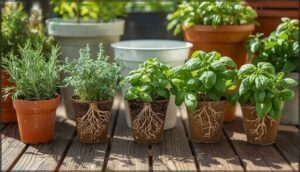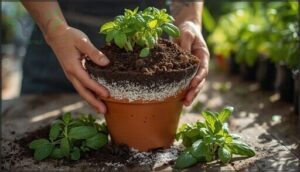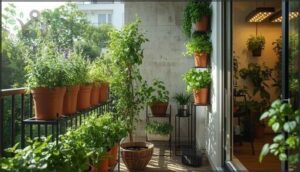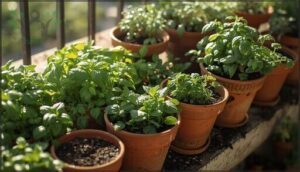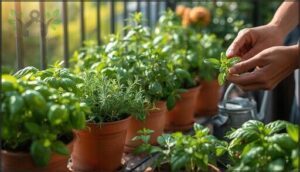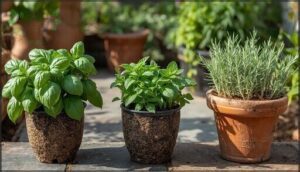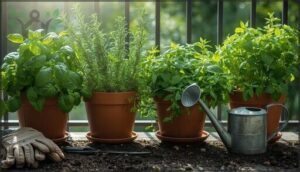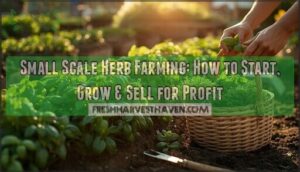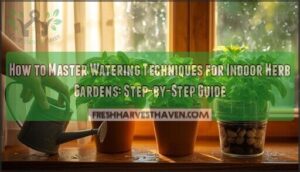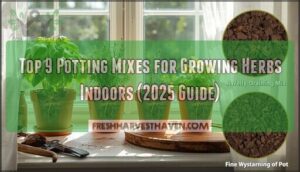This site is supported by our readers. We may earn a commission, at no cost to you, if you purchase through links.
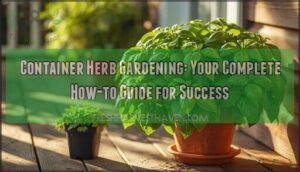
Whether you crave the punch of rosemary or the delicate aroma of parsley, the right setup means you call the shots. With the right choices, your countertop can rival any garden bed, and your harvests will speak for themselves.
Table Of Contents
- Key Takeaways
- Choosing Herb Containers
- Herb Pairing Guidelines
- Herb Care and Maintenance
- Herb Specific Growing Conditions
- Container Herb Garden Tips
- Frequently Asked Questions (FAQs)
- Which herbs grow well in pots?
- What herbs should not be potted together?
- How deep of a container do you need for herbs?
- How many herbs can I plant in a 5 gallon bucket?
- Can herbs be grown indoors year-round successfully?
- Which herbs are easiest for beginners to grow?
- How often should container herbs be replanted?
- What are the best herbs for cooking?
- Can you grow herbs from kitchen scraps?
- How can I start herbs from seed indoors?
- Conclusion
Key Takeaways
- Giving herbs plenty of space in large, well-draining containers boosts growth and harvests, sometimes doubling leaf size.
- Pairing compatible herbs like basil and rosemary maximizes yields and pest resistance, while aggressive varieties like mint and fennel need their own pots to avoid root warfare.
- Most container herbs need 6–8 hours of direct sunlight, quality soil mixes, and regular pruning to stay healthy and flavorful.
- Watering and fertilizing schedules should match each herb’s specific needs, with vigilant pest monitoring to protect your crop.
Choosing Herb Containers
Your container choice sets the foundation for everything your herbs will do—grow strong, stay healthy, or struggle to survive. The right pot isn’t just about looks; it’s about giving your plants the space, drainage, and conditions they need to thrive.
Here’s what you need to keep in mind when selecting containers for your herb garden.
Size and Material Considerations
Right-sizing your container herb gardening setup breaks you free from gardening limitations. You’ll need containers at least 14 inches in diameter—go bigger with 5-gallon pots for perennials like rosemary and sage. Container depth of 8-12 inches gives roots room to stretch. Here’s what really matters for herbs in containers:
- Pot material shapes moisture: Plastic holds water; terra cotta breathes
- Soil volume drives yields: Larger pots boost growth by 25%
- Insulation types matter: Light-colored containers prevent root damage from heat
- Container garden design needs drainage: Multiple holes prevent waterlogging.
Understanding herb growth patterns is essential for a successful container herb garden.
Drainage and Soil Requirements
Container size won’t save your herbs if drainage fails. You need holes spaced every 3-4 inches at the bottom—this single step cuts root rot risk by 80%. Pair that with a high-quality potting mix: two parts potting soil, one part compost, and one part perlite or coarse sand. This combination delivers good drainage while maintaining a moisture management balance. Herbs in containers are known for requiring less weeding.
| Soil Component | Purpose | Impact |
|---|---|---|
| Perlite/Sand | Increases air pockets | Prevents anaerobic conditions |
| Compost | Adds nutrients | Encourages vigorous growth |
| Quality Mix | Maintains pH 6.0-7.0 | Optimizes nutrient uptake |
Soil conditions matter—skip clay-heavy mixtures that compact and trap water.
Sunlight and Placement Options
Your soil drains perfectly, but placement determines whether your herbs thrive or just survive. Most herbs in containers demand 6-8 hours of direct sunlight daily for peak exposure—southern or western spots deliver the strongest light intensity. Mediterranean varieties like rosemary and oregano flourish in this full-sun environment, while partial shade (4-6 hours) suits cilantro and mint better.
Strategic positioning transforms results:
- Balcony edges and window boxes capture maximum sunlight exposure without structural interference
- Container rotation weekly ensures uniform growth across all sides, preventing leggy, lopsided plants
- Vertical gardens and tiered stands multiply your growing space while giving each herb adequate light
- Indoor lighting setups with LED grow lights positioned 6-12 inches above plants sustain indoor herb gardening year-round
- Mobile containers adapt to seasonal changes, letting you chase ideal light as sun angles shift
Outdoor herb gardening offers enhanced natural light, but container gardening’s mobility lets you fine-tune placement until conditions are perfect.
Herb Pairing Guidelines
Not all herbs play well together in the same pot. Some thrive on neglect while others demand constant attention, and pairing the wrong ones can leave you with wilted disappointments instead of a thriving garden.
Let’s break down which herbs make great roommates and which ones need their own space.
Compatible Herb Combinations
Successful herb pairings maximize yields and resilient growth. Aromatic pairings like basil, rosemary, and thyme thrive in Mediterranean combinations, boosting leaf mass by up to 19% through complementary growth habits. For space optimization and pest management, basil and rosemary together reduce pest pressure by 60% while improving soil health.
You’ll maximize culinary utility by grouping parsley, oregano, and chives—chefs prefer this trio for flavor blending.
Even mint benefits from strategic pairing when given its own container with rich organic matter.
Incompatible Herb Pairings
When certain herbs share container space, they wage chemical warfare beneath the soil. Allelopathic effects from fennel suppress neighboring growth by 60%, while mint’s aggressive roots strangle companions within months—robbing them of water and nutrients through fierce growth competition. These incompatible pairings sabotage your harvest before you realize what’s happening.
When incompatible herbs share a pot, underground chemical warfare and aggressive roots can sabotage your harvest before you even notice
Here are three notorious combinations that guarantee failure:
- Fennel with basil or oregano – allelopathic compounds stunt nearby plants
- Mint with anything delicate – rhizomes hijack 90% of container space
- Rosemary with moisture-loving herbs – conflicting environmental needs stress both
Beyond root warfare, pest attraction escalates when dill joins parsley, while flavor degradation ruins your culinary goals. Master these restrictions, and you’ll transform your herb care strategy.
Considering Growth Habits and Needs
Mismatched growth rates doom your herb pairings faster than neglect. When basil matures in 4–6 weeks while rosemary demands 4–8 weeks, you’re juggling incompatible harvest cycles. Plant density matters—12-inch spacing for fast growers prevents root system competition, while compact herbs like thyme thrive in 6–8 inch spaces.
Smart soil management and light requirements separate thriving herb plant care from container gardening chaos.
| Growth Factor | Fast-Growing (Basil, Cilantro) | Slow-Growing (Rosemary, Sage) |
|---|---|---|
| Maturity Time | 4–6 weeks | 4–8 weeks |
| Container Size | 8–10 inches diameter | 12–18 inches diameter |
| Spacing Needs | 12 inches between plants | 18+ inches for airflow |
Herb Care and Maintenance
You’ve got your herbs planted and paired—now comes the real work of keeping them alive and thriving. Container herbs don’t follow a one-size-fits-all care routine, so understanding their individual needs makes all the difference.
Let’s break down the essentials: watering schedules, fertilization tactics, and pest management strategies that’ll keep your herbs healthy without turning you into a helicopter gardener.
Watering and Hydration Needs
You can’t treat all herbs the same regarding watering—it’s the fastest way to kill your plants. Check soil moisture by sticking your finger two inches deep; water deeply when the top layer feels dry.
Basil demands consistent hydration, while rosemary and other drought-tolerant Mediterranean herbs thrive with drier conditions between waterings. Proper watering techniques respect each herb’s unique water retention needs and prevent both wilting and root rot.
Fertilization and Pruning Techniques
Your container herbs won’t reach their full potential without strategic feeding and deliberate trimming. For proper growth regulation, apply water-soluble fertilizers at 100–300 ppm nitrogen every two weeks during active growth—this maintains nutrient balance while avoiding the buildup issues you’d get from synthetic overuse. Organic soil amendments like 3-3-3 to 5-5-5 granular blends work beautifully at 2 cups per cubic foot of potting mix.
Pruning schedules matter: trim stems back by one-third every two weeks once plants hit 6–8 inches tall to trigger bushier growth. These container gardening tips transform lanky, sparse herbs into productive powerhouses. Different fertilization methods and pruning techniques directly impact your harvest quality and volume.
Monitoring and Preventing Pests
Overlooked infestations can slash your container herb yields by 70% in just three weeks—that’s why pest monitoring separates thriving gardens from failed experiments.
Set up sticky cards and inspect plants weekly for early pest identification of aphids, whiteflies, and spider mites. Apply insecticidal soap at first signs to achieve 85% reduction in soft-bodied pests.
Use biological barriers like diatomaceous earth against slugs, and space containers properly—airflow alone cuts outbreaks by 50%. These organic controls protect your harvest without compromising edibility.
Herb Specific Growing Conditions
Not all herbs play by the same rules. Each one has its own quirks regarding temperature, soil type, and how much sun it actually needs to thrive in a container.
Let’s break down what your herbs are really asking for so you can give them exactly what they need.
Temperature and Sunlight Requirements
Ever wonder why your basil wilts after a cool night, while mint stands tall in the shadows? That’s the power of temperature and sunlight at play in herb gardening in containers. Most herbs crave sunlight hours and ideal temperature—think 65–75°F by day, with a gentle drop at night. Mediterranean herbs like rosemary and thyme demand high light intensity, while shade-tolerant varieties such as mint and chives adapt to less sunlight exposure. If you want vigorous growth, keep your containers south-facing and rotate them for even light. Protect sensitive herbs from heat stress and cold protection by moving them indoors or using shade cloths.
- Ideal Temperature: 65–75°F daytime, cooler nights
- Sunlight Hours: 6–8 for Mediterranean, 2–4 for shade-tolerant
- Light Intensity drives flavor and compactness
- Heat Stress harms roots in direct sun
- Cold Protection needed below 50°F
Soil and Moisture Preferences
Once you’ve nailed temperature and sunlight, it’s time to master Soil Composition and Moisture Levels. Herbs are rebels—each with its own demands. Basil and parsley crave fertile, moist soil and steady Water Retention, while rosemary and thyme want sandy Potting Mixes that dry out between drinks. Mint and cilantro push for rich, organic Soil Quality and regular watering.
If your Drainage Systems lag, roots suffocate and yields suffer. For best results, use soilless mixes with perlite or coarse sand to balance moisture and air. Always test soil conditions with your finger—dry means it’s time for Watering Herbs. Adapt Watering Needs to your herb’s personality.
Hardiness Zones and Regional Considerations
You’ve mastered soil and moisture, but let’s talk about how your zip code shapes your herb game. Hardiness Mapping isn’t just a fancy chart—it’s the key to Zone Selection and survival. Chives and catnip scoff at icy Zone 3 winters, while rosemary and lavender pine for Mediterranean summers. Your containers crank up Temperature Fluctuations, so those roots feel every chill. South-facing walls, sheltered corners, and savvy Frost Protection can stretch your limits. Growing Herbs in Containers means knowing your region’s quirks and timing—frost dates, sun angles, and local weather. Herb Gardening for Beginners and rebels alike, embrace your microclimate. Adapt, protect, and let your Container Garden Maintenance set you free.
- Push boundaries, not just pots
- Outsmart winter’s bite
- Utilize your microclimate
- Let local weather guide you
- Make every square foot count
Container Herb Garden Tips
Ready to keep your container herbs thriving all season long? There are a few smart strategies that can make a world of difference.
Here’s what you’ll want to keep in mind as you care for your plants.
Harvesting and Pruning Strategies
Slice into your container garden’s bounty with precision, and you’ll trigger substantial Leaf Regrowth and flavor. Pruning Techniques aren’t just busywork—they’re your ticket to higher Regrowth Rates and tastier harvests.
For instance, Harvest Timing matters: cut basil and sage in the morning for peak oil content. Use Stem Cutting just above leaf pairs to spark new shoots. When Harvesting Herbs like parsley, target outer stems at soil level.
Here’s a quick reference table for your Herb Harvesting Techniques:
| Herb | Harvest Timing | Pruning Method |
|---|---|---|
| Basil | Morning, pre-flower | Cut 1–2” above leaf pairs |
| Sage | Early morning | Clip above leaf pairs |
| Parsley | Outer leaves first | Cut stems at soil level |
Managing Vigorous Herb Growth
After you’ve sharpened your Harvesting Techniques, it’s time to tackle the wild side of container gardening: Vigor Control. Mint, oregano, and chives will run riot if you let them.
Herb Thinning and Root Pruning are your secret weapons—snip, pinch, and divide root masses annually. This Growth Regulation keeps your herb garden balanced, productive, and ready for bold, flavorful harvests.
Overwintering and Year-Round Care
Often, winter puts your rebellious container herb garden to the test. You’ll need strategic Winter Protection—move basil and other tender herbs indoors before frost strikes. Set up Indoor Lighting for 14–16 hours daily. Cold Frame Gardening shields hardy perennials like thyme and sage outdoors.
For bold, year-round Herb Garden Care and Maintenance, focus on:
- Mulching containers for root insulation
- Seasonal Pruning to control growth
- Smart Frost Management for survival
Frequently Asked Questions (FAQs)
Which herbs grow well in pots?
You’ve got options—basil, rosemary, thyme, sage, oregano, parsley, cilantro, chives, mint, and lemon balm all thrive as herbs in containers.
Pick sturdy pots, use quality potting mix, and match herbs to their ideal growing conditions.
What herbs should not be potted together?
Think of mint as a wild card—its roots will overrun any neighbor. Herb Incompatibility boils down to Growth Conflicts and mismatched Sunlight Needs.
Rosemary and parsley clash over Water Requirements, while thyme, sage, and oregano shun basil’s thirst.
How deep of a container do you need for herbs?
Most herbs thrive in containers at least 8–12 inches deep, matching their root depth and size. For healthy perennials like rosemary or sage, choose a deeper, well-draining herb container for healthy growth and proper container garden care.
How many herbs can I plant in a 5 gallon bucket?
In a 5-gallon bucket, you can fit 3-5 compatible herbs with shallow root systems, like basil or cilantro.
For larger herbs, plant only one per bucket to avoid crowding and increase soil volume and bucket drainage.
Can herbs be grown indoors year-round successfully?
Funny how your kitchen window and a grow light can rival the sun—if you nail your lighting requirements indoors, maintain consistent temperatures, and manage pests, you’ll keep nutrient cycling humming and achieve vigorous indoor herb hardiness all year.
Which herbs are easiest for beginners to grow?
If you’re after beginner-friendly herbs, reach for basil, mint, chives, parsley, and rosemary.
These low-maintenance varieties are the fastest-growing and easiest culinary herbs—making them the best starter herbs for bold, flavor-packed kitchen experiments.
How often should container herbs be replanted?
Ever wondered why your herbs suddenly stall or wilt? Watch for root-bound signs and soil degradation.
Annuals need replanting each year, while perennials thrive with replanting every 2–3 years, timed to growth cycles and local climate factors.
What are the best herbs for cooking?
Basil, parsley, sage, rosemary, and thyme are your flavor powerhouses. Each boasts a distinct flavor profile, wide-ranging culinary uses, high nutritional value, and grows easily.
Harvest often and preserve with drying or freezing to keep their punch year-round.
Can you grow herbs from kitchen scraps?
You might think wilted herbs are destined for compost, but Scrap Viability is surprisingly high. With proper Propagation Methods—water, light exposure, and temperature needs—mint, basil, and cilantro scraps can regrow, revolutionizing Growing Herbs in Containers for adventurous gardeners.
How can I start herbs from seed indoors?
To start herbs from seed indoors, focus on proper seed sowing depth, maintain high humidity for germination, use full-spectrum grow lights for best light intensity needs, control temperature, and harden seedlings before transplanting for successful herb gardening basics.
Conclusion
What’s stopping you from transforming a simple pot into a powerhouse of flavor and fragrance? With container herb gardening, you hold the reins—choosing the soil, pairing the right herbs, and mastering their care.
Each decision shapes a living tapestry right at your fingertips. Whether you crave bold basil or resilient rosemary, your container garden stands as proof: control and creativity can coexist.
So let your herbs stretch, thrive, and surprise you—your porch has never looked, or tasted, so alive.
- https://bonnieplants.com/blogs/garden-fundamentals/why-grow-vegetables-and-herbs-in-pots
- https://www.gardenary.com/blog/how-to-grow-herbs-in-a-small-space
- https://homesteadingfamily.com/container-gardening/
- https://planttalk.colostate.edu/topics/annuals-perennials/1081-growing-herbs-containers/
- https://foodgardening.mequoda.com/daily/container-gardening/the-challenges-of-growing-vegetables-in-containers-and-how-to-overcome-them/

